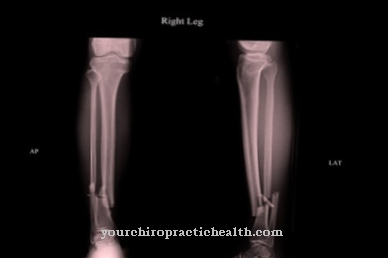The Long-term potentiation is the basis for neural plasticity and thus the reshaping of neural structures or interconnections in the nervous system. Without the process, neither the formation of a memory nor learning experiences would be possible. Disorders of long-term potentiation occur, for example, in diseases such as Alzheimer's.
What is long-term potentiation?

Neurons work with bioelectrical and biochemical action potentials. The action potentials are the language of the central nervous system and serve to transmit excitation. This transmission is also known as synaptic transmission. Nerve cells react to the increased generation of action potentials with a so-called long-term potentiation.
Neural plasticity is one of the most important consequences of long-term potentiation. The term neural plasticity describes a remodeling within the neural structure that adapts it to its current use. Both individual nerve cells and brain areas can be rebuilt neuronally. By means of the conversion processes, the functions of the central and peripheral nervous system are preserved, expanded and adapted to the current usage situation. As the basis of the neural reconstruction, long-term potentiation helps enormously to ensure that the nervous system functions as effectively and smoothly as possible.
Long-term potentiation is also associated with memory formation. In addition, the reconstruction of the neural structures is an inevitable process for learning processes.
Function & task
From the point of view of the brain, a learned skill is assigned a morphological correlate, which corresponds to a network of synaptic connections. Such networks allow the formation of ideas in the association cortex. When a certain word is pronounced, for example, a special network must be activated, which in turn results in a special pattern of action potentials.
Whenever a person learns new skills or improves old ones, new interconnections arise in the brain. Interconnections that are not used are canceled again in the same way. This remodeling corresponds to synaptic plasticity. Learning at the neural level is therefore an activity-dependent reconstruction of patterns in the neural interconnection and of functional processes in the brain.
In addition to presynaptic reinforcement, post-tetanic potentiation and synaptic depression, long-term potentiation is also relevant for learning processes. This potentiation corresponds to a long-term amplification of synaptic transmissions. This process consists of various sub-processes.
The activation of AMPA receptors is the first step in long-term potentiation. There are innumerable receptors for glutamate in the postsynaptic membranes. A subgroup of these glutamate receptors are those of the AMPA type. As soon as an action potential is generated, glutamate is released. The body's own substance is one of the most important neurotransmitters and, after being released, binds to AMPA receptors, which are made to open by binding. After the receptors open, sodium ions flow in. This creates an excitatory postsynaptic potential. This potential arises with every depolarization within the postsynaptic membrane. Exciting postsynaptic potentials are added up and processed by the receiving neuron. When a threshold value is exceeded, the receiving neurons form an action potential again and pass it on via their axons.
The generation of an excitatory postsynaptic potential is followed by activation of the NMDA receptors in long-term potentiation. As soon as additional action potentials occur, there is an increased depolarization of the postsynaptic membrane. Magnesium ions leave the NMDA receptor and the receptor can open. The opening of the NMDA receptors results in the influx of calcium ions and leads to a phosphorylation of the AMPA receptors. The phosphorylation in turn increases the conductivity of the receptors and also increases protein synthesis in the cell.
In addition, retrograde messenger substances are released during the processes described. These messenger substances correspond, for example, to derivatives of arachidonic acid or gases such as nitric oxide. These messenger substances cause the presynaptic membrane to release more neurotransmitters.
You can find your medication here
➔ Medicines against memory disorders and forgetfulnessIllnesses & ailments
Neurological diseases affecting long-term potentiation are a current subject of medical research. One such disease is Alzheimer's. Crohn's disease also has an impact on the processes described above. That these diseases disturb the long-term potentiation is mainly due to the degeneration of the nerve cells. As soon as the neuronal synapses break down, long-term potentiation is no longer possible. For example, this also creates the dark areas in their memory.
The brain breaks down bit by bit in degenerative diseases of the central nervous system. Measures to maintain the neural structures have become a main focus of research in relation to diseases such as Alzheimer's. So far, no great successes in the preservation of the synapses have been recorded. So far, groundbreaking successes have only been recorded in animals with comparable diseases. Scientists have not yet succeeded in transferring these successes to humans.
Since the long-term differentiation no longer works in those affected, no more synaptic remodeling can take place. Learning processes are impossible and the general functionality of the brain decreases progressively. New nerve cells or connections between neurons can no longer form. Old synapses are no longer used and are dismantled as part of renovation processes.
To counteract these processes, medicine now promotes the maintenance of the synapses by means of special exercises. The more frequently synapses are used, the sooner the brain recognizes them as necessary. Diseases such as Alzheimer's or Crohn's disease can therefore be delayed in their course through exercise. But so far it is impossible to stop the diseases through exercises. Most of those affected therefore need 24-hour care from a certain stage of the disease.












.jpg)



.jpg)










.jpg)
